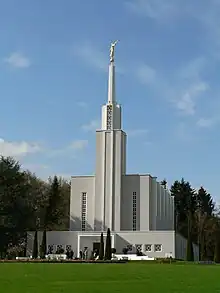Bern Switzerland Temple
The Bern Switzerland Temple (formerly the Swiss Temple) is a temple of the Church of Jesus Christ of Latter-day Saints (LDS Church), was the church's first temple built in Europe, and the second built outside of North America[1], after the Laie Hawaii Temple.
| Bern Switzerland Temple | ||||
|---|---|---|---|---|
 | ||||
| Number | 9 | |||
| Dedication | September 11, 1955, by David O. McKay | |||
| Site | 7 acres (2.8 ha) | |||
| Floor area | 35,546 sq ft (3,302.3 m2) | |||
| Height | 140 ft (43 m) | |||
| Official website • News & images | ||||
| Church chronology | ||||
| ||||
| Additional information | ||||
| Announced | July 1, 1952, by David O. McKay | |||
| Groundbreaking | August 5, 1953, by David O. McKay | |||
| Open house | September 9-10, 1955 October 8–17, 1992 | |||
| Rededicated | November 23, 1992, by Gordon B. Hinckley | |||
| Current president | Raimondo Castellani (2008) | |||
| Designed by | Edward O. Anderson | |||
| Location | Münchenbuchsee, Switzerland | |||
| Geographic coordinates | 47°0′7.891200″N 7°27′29.67839″E | |||
| Exterior finish | Cream terra cotta | |||
| Temple design | Modern, single spire | |||
| Baptistries | 1 | |||
| Ordinance rooms | 4 (Movie, stationary) | |||
| Sealing rooms | 7 | |||
| Clothing rental | Yes | |||
| Notes | Bern was the first temple to present the endowment using a movie, necessitated by the multiple languages required to support the members in Europe. | |||
| () | ||||
History

The 2.8-hectare (7-acre) lot was selected in July 1952 by LDS Church president David O. McKay and Samuel E. Bringhurst, then president of the Swiss-Austrian Mission.[2] The architects were Edward O. Anderson and Wilhelm Zimmer. Groundbreaking and dedication of the lot were performed by McKay on 5 August 1953.[1] He dedicated the temple on 11 September 1955. The temple was known as the "Swiss Temple" until the current naming convention for temples was adopted in the late 1990s.
The Bern Switzerland temple has four ordinance rooms, seven sealing rooms, and a total floor area of 3,302.3 square metres (35,546 sq ft). Its temple district includes stakes in France, Switzerland, and the district in Jerusalem, Israel.[3]
The presentation of the endowment was particularly challenging in this temple, because it was the first international one, requiring many different languages for its attendants. It was solved by using a film, dubbed in all required languages. Gordon B. Hinckley supervised the initial making of this film and was the person responsible for transporting the film to Switzerland.[4] Since then all new temples have been equipped with recordings in lieu of live presentations by temple workers. Today, only the Manti Utah Temple and the Salt Lake Temple use live presentation instead of film (although the church announced in 2021 that these temples will convert to use of film after extensive remodeling).
After the complete renewal of the interior, the temple was rededicated by Hinckley, who was then a member of church's First Presidency, on 23 October 1992.[1] In connection with the fiftieth anniversary of its dedication, a 4-metre-tall (13 ft) statue of the angel Moroni was erected on top of the tower on 7 September 2005.
In 2020, like all the church's other temples, the Bern Switzerland Temple was closed in response to the coronavirus pandemic.[5]
The Bern Switzerland temple is featured briefly in the Woodkid music videos for "Iron" and "Run Boy Run". Though the building is located in Münchenbuchsee, its postal address is assigned to the neighboring municipality of Zollikofen.
See also
- Comparison of temples of The Church of Jesus Christ of Latter-day Saints
- List of temples of The Church of Jesus Christ of Latter-day Saints
- List of temples of The Church of Jesus Christ of Latter-day Saints by geographic region
- Temple architecture (Latter-day Saints)
- The Church of Jesus Christ of Latter-day Saints in Switzerland
References
- Toone, Trent. "The Bern Switzerland Temple, first in Europe, reaches 60-year milestone", Deseret News, 10 September 2015. Retrieved on 17 March 2020.
- Cowan, Richard O. "The Pivotal Swiss Temple", Regional Studies in Latter-day Saint Church History: Europe, 2003. Retrieved on 17 March 2020.
- "Bern Switzerland Temple District". Retrieved October 29, 2018.
- Dew, Sheri L. (1996), Go Forward with Faith: A Biography of Gordon B. Hinckley, Salt Lake City, Utah: Deseret Book, p. , ISBN 1573451657, OCLC 35364667
- Stack, Peggy Fletcher. "All Latter-day Saint temples to close due to coronavirus", The Salt Lake Tribune, 26 March 2020. Retrieved on 28 March 2020.
External links
- Bern Switzerland Temple Official site
- Bern Switzerland Temple at ChurchofJesusChristTemples.org
